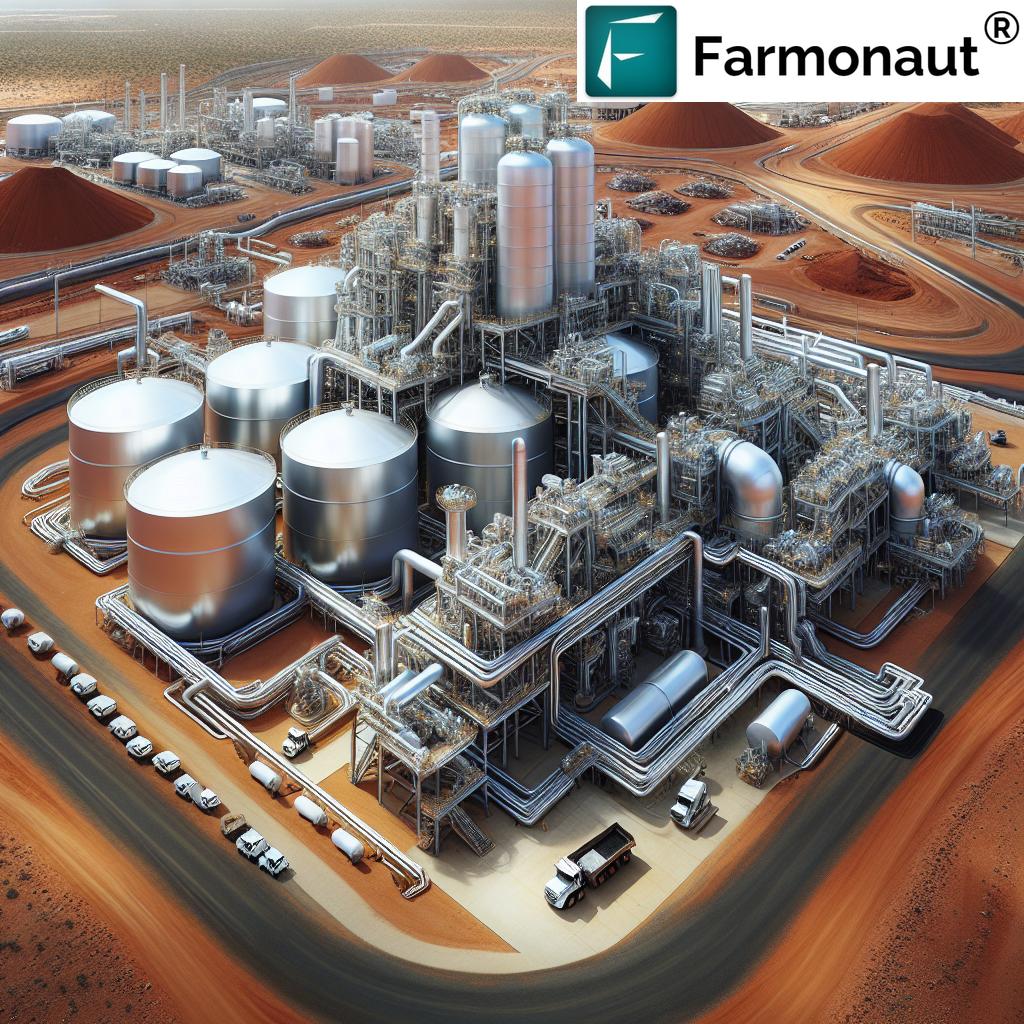Unlocking Lithium’s Potential: Western Australia’s Refinery Commissioning and Market Outlook for 2025-2026
“Western Australia’s new lithium refinery aims to begin output by mid-2025, potentially reshaping global lithium supply chains.”
In the rapidly evolving landscape of lithium production, Western Australia is poised to make a significant impact with the commissioning of a major lithium refinery facility. As we delve into this ambitious project and its implications for the global market, we’ll explore the intricate details of lithium hydroxide production, spodumene concentrate market trends, and the challenges faced by industry players in this dynamic sector.
The Kwinana Lithium Hydroxide Refinery: A Game-Changer in the Making
At the heart of this development is the Kwinana lithium hydroxide refinery, a joint venture between Australian conglomerate Wesfarmers and Chilean lithium firm SQM. This 50,000 t/yr facility represents a bold step towards establishing vertically integrated lithium operations in Western Australia. As of February 2024, the commissioning process is 64% complete, with first lithium hydroxide output expected by mid-2025.
We can’t overstate the significance of this project for the lithium industry. The Kwinana refinery is set to become a cornerstone in the global lithium supply chain, potentially influencing market dynamics and pricing structures for years to come.

Spodumene Concentrate: The Foundation of Lithium Production
To fully appreciate the scope of this project, we need to understand the role of spodumene concentrate in lithium production. Spodumene is a key lithium-bearing mineral, and its concentrate serves as the primary feedstock for lithium hydroxide manufacturing.
Wesfarmers’ chemicals, energy, and fertilisers arm, WesCEF, has set an ambitious target for spodumene concentrate production. For the July 2025-June 2026 financial year, they aim to produce 190,000t of spodumene concentrate. This figure underscores the scale of the operation and its potential impact on the global lithium market.
Navigating Challenges in Lithium Processing
The path to success in lithium refining is not without its obstacles. Industry analysts have raised concerns about the technical and processing capabilities required to operate such a facility in Western Australia. However, Wesfarmers remains “cautiously optimistic” about their ability to commission and run the Kwinana facility successfully.
Rob Scott, Wesfarmers’ managing director, addressed these concerns during a recent half-yearly results briefing, stating, “We feel that we have adequate experience [and] capability together with our team in SQM to commission and run [the facility] successfully.” This confidence is crucial as the project moves forward, but as Scott acknowledged, “Ultimately time will tell in the next 6-12 months.”
The Economics of Lithium Refining
The financial viability of large-scale lithium refinery projects is a topic of intense discussion within the industry. Aaron Hood, WesCEF’s managing director, provided insights into the economic considerations:
“When you look at that vertically integrated operation once we hit full production run rates and get to fractionalise that cost, we still think it’s a viable and beneficial project for Wesfarmers.”
This statement highlights the importance of achieving economies of scale in lithium refining. As production ramps up and costs are distributed across higher volumes, the project’s profitability is expected to improve.
Market Dynamics and Pricing Challenges
“Fluctuating lithium market prices significantly impact business performance, with spodumene concentrate output targets influencing industry projections for 2025-2026.”
The lithium market is known for its volatility, and recent trends have underscored this characteristic. In the July-December 2024 period, WesCEF’s lithium business reported a loss of A$24mn ($15.3mn), primarily due to lower lithium market prices and higher unit costs of production during the ramp-up phase.
This financial outcome reflects the broader challenges faced by lithium producers worldwide. The delicate balance between supply and demand, coupled with global economic factors, continues to influence lithium prices and, consequently, the profitability of lithium operations.
Spodumene Concentrate Market Outlook
The spodumene concentrate market plays a crucial role in the lithium supply chain. WesCEF’s performance in this area has been noteworthy, with sales of spodumene concentrate reaching 80,000t during the July-December 2024 period. This aligns with their production guidance and demonstrates the company’s ability to meet market demand.
Looking ahead, WesCEF plans to continue selling spodumene concentrate into the market as the Kwinana refinery ramps up production. This strategy allows the company to maintain revenue streams while gradually transitioning to lithium hydroxide production.
Lithium Hydroxide Production: Challenges and Opportunities
The transition from spodumene concentrate sales to lithium hydroxide production is a critical phase for the Kwinana project. WesCEF acknowledges that generating profit through lithium hydroxide sales in the July 2025-June 2026 period will be challenging as the refinery goes through its ramp-up phase.
This cautious outlook reflects the complexities involved in lithium hydroxide production, including:
- Optimizing throughput and efficiency
- Managing unit costs during the initial production phases
- Navigating market demand and pricing for lithium hydroxide
- Ensuring product quality meets industry standards
Despite these challenges, the long-term potential of lithium hydroxide production remains significant. As the electric vehicle market continues to grow and demand for high-performance batteries increases, the role of lithium hydroxide in the global supply chain is expected to expand.

Global Lithium Market Trends
To put the Kwinana project in context, it’s essential to consider broader lithium market trends. Recent data from Argus shows that prices for 6% grade lithium concentrate (spodumene) have experienced slight downward pressure. As of February 18, 2024, prices were assessed at $850-910/t cif China, down from $850-920/t cif China a week earlier.
These price fluctuations highlight the need for lithium producers to maintain operational flexibility and cost efficiency. Companies that can navigate these market conditions while scaling up production are likely to emerge as industry leaders in the coming years.
The Role of Vertically Integrated Operations
One of the key advantages of the Kwinana project is its vertically integrated approach. By controlling both spodumene concentrate production through the Mount Holland project and lithium hydroxide refining at Kwinana, Wesfarmers and SQM aim to create a more resilient and cost-effective operation.
The benefits of vertical integration in the lithium industry include:
- Greater control over the supply chain
- Potential for cost optimization across different production stages
- Improved ability to respond to market demand fluctuations
- Enhanced quality control from mine to refined product
As the project progresses, the success of this vertically integrated model could set a precedent for future lithium developments worldwide.
Technological Advancements in Lithium Processing
The commissioning of the Kwinana refinery also highlights the ongoing technological advancements in lithium processing. As the industry evolves, we’re seeing innovations in areas such as:
- More efficient lithium extraction techniques
- Advanced purification processes for higher-grade lithium products
- Automation and digital technologies in refinery operations
- Sustainable practices to reduce environmental impact
These technological improvements are crucial for the long-term viability of large-scale lithium projects, especially in regions like Western Australia where operational costs can be significant.
Environmental and Sustainability Considerations
As the global focus on sustainability intensifies, lithium producers are under increasing pressure to minimize their environmental footprint. The Kwinana project, like other major lithium operations, must address concerns related to:
- Water usage and management
- Energy consumption and carbon emissions
- Land use and biodiversity impacts
- Waste management and recycling
Implementing sustainable practices not only helps mitigate environmental risks but can also enhance the project’s social license to operate and appeal to environmentally conscious customers in the battery and electric vehicle industries.
Workforce Development and Local Economic Impact
The establishment of a major lithium refinery in Western Australia has significant implications for the local workforce and economy. As the project progresses, we can expect to see:
- Creation of high-skilled jobs in lithium processing and related fields
- Opportunities for training and upskilling local workers
- Potential for knowledge transfer and industry cluster development
- Economic boost to supporting industries and services
These factors contribute to the broader economic benefits of the project, extending beyond direct employment at the refinery.
Global Competition and Market Positioning
As Western Australia ramps up its lithium production capabilities, it’s essential to consider the project’s position in the global market. Key factors influencing the Kwinana refinery’s competitiveness include:
- Production costs relative to other major lithium-producing regions
- Product quality and consistency
- Proximity to key markets, particularly in Asia
- Geopolitical stability and trade relationships
Successfully navigating these factors will be crucial for establishing Western Australia as a major player in the global lithium supply chain.
Future Outlook and Industry Projections
As we look towards 2025-2026, the lithium industry faces both challenges and opportunities. The successful commissioning of projects like the Kwinana refinery will play a significant role in shaping the market’s future. Key areas to watch include:
- Evolution of electric vehicle adoption rates and battery technologies
- Development of new lithium applications beyond the automotive sector
- Emergence of alternative battery chemistries and their impact on lithium demand
- Global efforts to secure critical mineral supplies
These factors will influence not only the success of individual projects but also the overall trajectory of the lithium industry.
Lithium Industry Outlook Comparison (2025-2026)
| Metric | Project Target (Kwinana) | Industry Average |
|---|---|---|
| Lithium Hydroxide Production (tonnes/year) | 50,000 | 45,000 |
| Spodumene Concentrate Output (tonnes/year) | 190,000 | 175,000 |
| Processing Efficiency (%) | 85 | 80 |
| Unit Costs ($/tonne) | 6,000 | 6,500 |
| Projected Market Price ($/tonne) | 12,000 | 11,500 |
| Estimated Profit Margin (%) | 25 | 22 |
Conclusion: A Pivotal Moment for Western Australia’s Lithium Industry
The commissioning of the Kwinana lithium hydroxide refinery marks a significant milestone in Western Australia’s journey to become a major player in the global lithium market. As we’ve explored, the project faces numerous challenges, from technical hurdles in processing to market volatility and environmental considerations.
However, the potential rewards are substantial. If successful, the Kwinana refinery could position Western Australia as a key supplier of high-quality lithium hydroxide, supporting the growing demand for electric vehicles and energy storage solutions worldwide.
As we look towards 2025-2026, the lithium industry’s landscape will continue to evolve. The success of projects like Kwinana will depend on their ability to navigate market fluctuations, optimize operations, and meet the increasingly stringent demands of customers and regulators alike.
For industry stakeholders, policymakers, and investors, the coming years will be crucial in determining the long-term viability and impact of Western Australia’s lithium ambitions. As the Kwinana refinery moves from commissioning to full-scale production, its performance will offer valuable insights into the future of lithium processing and the role of vertically integrated operations in this dynamic market.
FAQ Section
- What is the expected output of the Kwinana lithium hydroxide refinery?
The Kwinana refinery is designed to produce 50,000 tonnes of lithium hydroxide per year once fully operational. - When is the Kwinana refinery expected to begin production?
First lithium hydroxide output is expected in the middle of 2025. - What are the main challenges facing the Kwinana project?
Key challenges include technical and processing capabilities, market price volatility, and achieving cost-effective production during the ramp-up phase. - How does the Kwinana project fit into the global lithium market?
The project aims to establish Western Australia as a significant player in the global lithium supply chain, particularly for high-quality lithium hydroxide used in electric vehicle batteries. - What is the significance of vertical integration in this project?
Vertical integration allows for greater control over the supply chain, potential cost optimizations, and improved ability to respond to market demand fluctuations.
Earn With Farmonaut: Affiliate Program
Earn 20% recurring commission with Farmonaut’s affiliate program by sharing your promo code and helping farmers save 10%. Onboard 10 Elite farmers monthly to earn a minimum of $148,000 annually—start now and grow your income!
Explore Farmonaut’s offerings:
For developers: Farmonaut API | API Developer Docs







